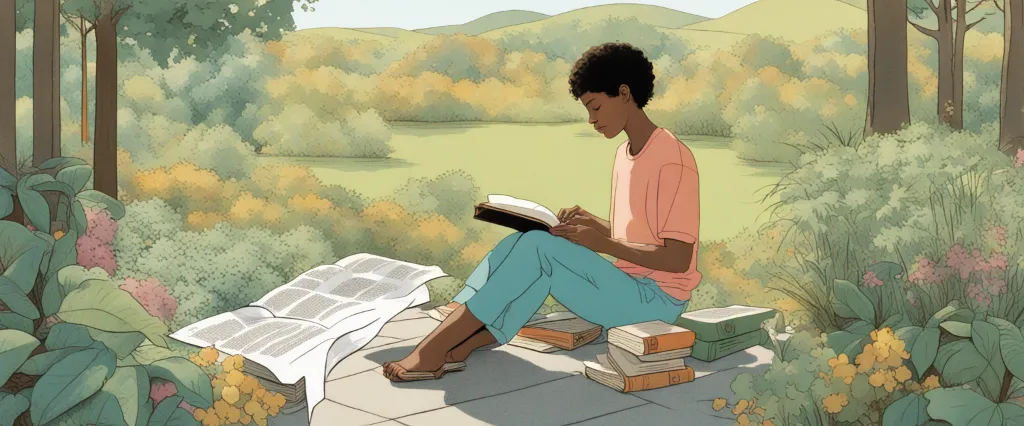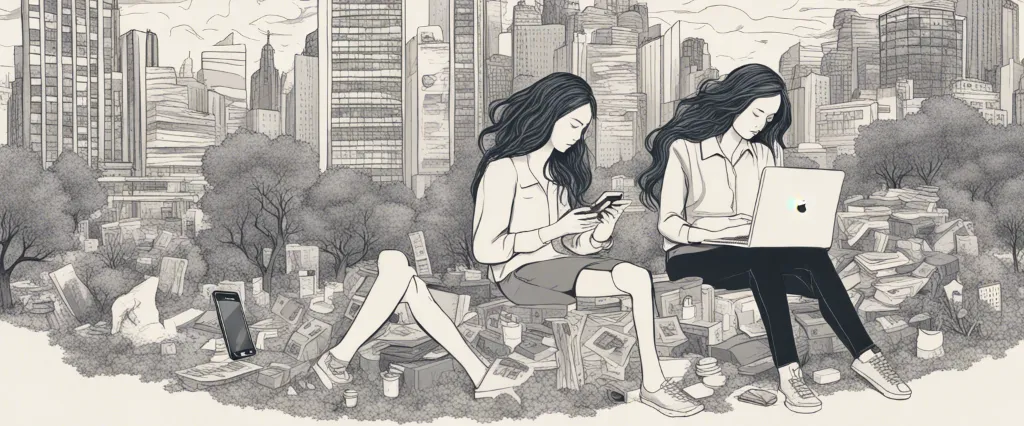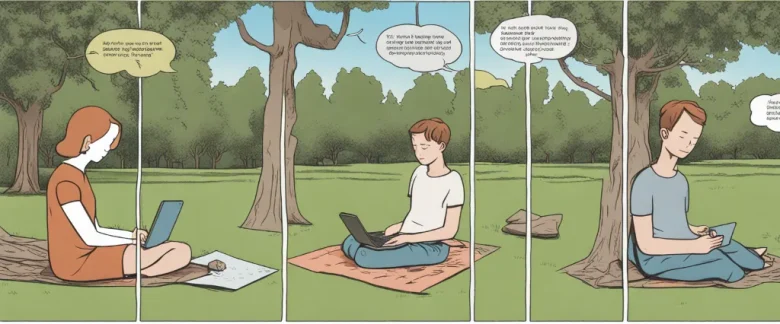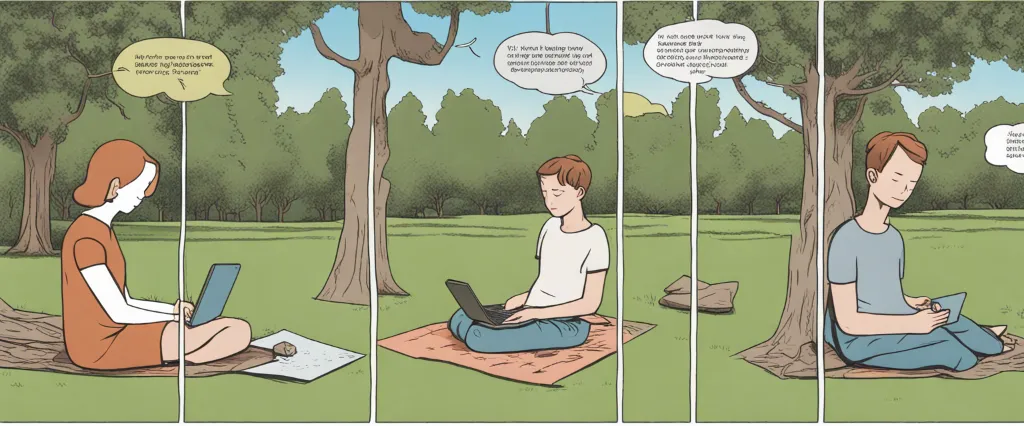In “How to Do Nothing,” Jenny Odell invites readers on a compelling journey towards reclaiming our attention and discovering the value of localized presence in an increasingly distractible world. Drawing on diverse disciplines like art, philosophy, and environmentalism, Odell challenges the dominant narrative of productivity and offers a refreshing perspective on the importance of “doing nothing.” A multi-disciplinary artist and writer based in Oakland, California, Odell combines her background in studio art and literature to examine the ways in which technology, capitalism, and social media have shaped our lives and limited our ability to truly connect with the world around us. With thought-provoking insights and practical advice, Odell unlocks the potential for radical change by embracing the power of stillness and reimagining the idea of productivity in our modern society.
Chapter 1: The Art of Redefining “Doing Nothing”
Chapter 1 of “How to Do Nothing” by Jenny Odell is titled “The Art of Redefining ‘Doing Nothing.'” In this chapter, Odell explores the concept of doing nothing as a form of resistance against the demands of the attention economy and capitalist productivity.
Odell begins by discussing the effects of modern technology and social media on our ability to focus and experience genuine leisure. She argues that these platforms are designed to capture and commodify our attention, leaving us constantly distracted and disconnected from the natural world. By engaging with these technologies, we are trapped in a cycle of constant production and consumption, which hinders our ability to truly engage with the world around us.
The author introduces the idea of “birdwatching for the soul,” a practice that involves observing the natural world and embracing moments of stillness and contemplation. She describes her experiences of birdwatching in her local park, where she witnesses the subtle beauty of birds and their interactions with the environment. Through this practice, Odell emphasizes the importance of paying attention and actively engaging with our surroundings to find inspiration, connection, and a sense of purpose.
Odell also discusses the value of leisure activities that are rooted in community and the sharing of resources. She highlights the benefits of local gardens and other communal spaces where individuals can come together to grow food, foster relationships, and develop a greater sense of agency.
Ultimately, Chapter 1 offers a critique of the attention economy and highlights the need to reclaim our time and attention. It encourages readers to redefine the idea of doing nothing by engaging in activities that promote connection, reflection, and engagement with the natural world and our local communities.
Chapter 2: The Importance of Disconnecting from Digital Noise
Chapter 2 of “How to Do Nothing” by Jenny Odell delves into the significance of disconnecting from the constant digital noise that surrounds us. Odell addresses the overwhelming nature of social media platforms and their impact on our lives, suggesting that they are designed to keep us engaged and addicted. She argues that their addictive nature robs us of our ability to inhabit the present moment fully.
Odell highlights the value of “deep attention,” a state of mind in which one is fully engaged with their surroundings and can appreciate the complexity and nuance of their environment. She argues that digital distractions prevent us from engaging in deep attention, thereby reducing our capacity for critical thinking and creativity.
Furthermore, the chapter examines the concept of “interval,” defined as a gap in perception where new possibilities can emerge. Odell suggests that by disconnecting from digital distractions, we create room for these intervals to occur. This allows us to find meaning in seemingly mundane activities and embrace the beauty of doing nothing.
The author emphasizes the importance of reclaiming our time and reclaiming our attention. By consciously disconnecting from digital noise, Odell argues that we can rediscover our connection to the physical world and our ability to be present. This act of disconnection becomes an act of resistance against the attention economy, reclaiming our attention as a valuable resource.
Overall, Chapter 2 encapsulates the notion that by disconnecting from digital distractions, we can reestablish our connection to the world around us and nurture our ability to engage deeply and meaningfully with our surroundings.
Chapter 3: Deep Observation and Interaction with Nature
Chapter 3 of “How to Do Nothing” by Jenny Odell focuses on the importance of deep observation and interaction with nature in a world overwhelmed by distractions and technology. Odell emphasizes the transformative power of paying attention to the natural world and the ways it can nourish our creativity, well-being, and sense of connection with our surroundings.
The chapter starts with Odell recounting her childhood experiences of exploring the outdoors and making observations about plants, insects, and animals. She contrasts these memories with the constant notifications and distractions that dominate our present lives, leading to a disconnection from the natural environment. Odell argues that this disconnection has serious consequences for our mental health and overall understanding of the world.
To counter this disconnection, Odell suggests engaging in “deep observation,” a practice involving focused attention to detail and nuance. She considers birdwatching as an example of this practice, where people spend time carefully observing and learning about the behaviors and ecosystems of birds. Deep observation can be a meditative activity that allows us to slow down, sharpen our senses, and cultivate a sense of wonder.
Furthermore, Odell highlights the importance of having direct experiences with the natural world instead of relying solely on mediated representations, such as nature documentaries or social media posts. She advocates for creating opportunities for unstructured interactions with nature, spending time in parks, gardens, or wherever we can find traces of the non-human world.
By immersing ourselves in nature, Odell suggests that we can develop a greater appreciation for ecological systems, realize our interdependence with the natural world, and find inspiration for creative endeavors. Deep observation and interaction with nature can foster a sense of presence, connectedness, and ecological consciousness that are essential for understanding and taking action against the environmental challenges we face.
Chapter 4: Community Engagement and Sense of Place

Chapter 4: Community Engagement and Sense of Place of “How to Do Nothing” by Jenny Odell examines the importance of engaging with our local communities and cultivating a sense of place in order to resist the relentless pressures of productivity and consumerism. Odell argues that we can combat the attention economy by actively participating in the physical spaces and social fabric of our neighborhoods and connecting with the communities around us.
Odell emphasizes the need to prioritize direct engagement with our surroundings, rather than getting caught up in the virtual spaces of social media and the internet. By taking the time to notice the intricate details of our neighborhoods, such as the sounds of birds, the architecture, or the history embedded in the landscape, we can develop a deeper connection to our surroundings. This connection allows us to appreciate the unique character and history of the place we call home.
The author gives examples of community-led initiatives that foster a sense of place. These might include community gardens, local cooperatives, or neighborhood festivals. Such initiatives provide opportunities for individuals to come together, share skills and knowledge, and collectively shape the physical and social environment of their community.
Engaging in local politics is also highlighted as a crucial way to affect change in our immediate surroundings. By attending city council meetings, participating in local decision-making processes, or advocating for inclusive public spaces, individuals can actively contribute to shaping the future of their community.
Chapter 4 encourages readers to shift their focus from constantly seeking external validation and productivity to cultivating a deep sense of connection to the people, places, and history around them. By nurturing our communities and investing in our immediate environments, we can find a sense of purpose and belonging that is less reliant on the external pressures of the attention economy.
Chapter 5: Creative Resistance and Cultural Production
Chapter 5 of “How to Do Nothing” by Jenny Odell explores the concept of creative resistance and cultural production. Odell argues that in a society consumed by productivity and capitalist values, the act of doing nothing can be a form of resistance. Instead of constantly engaging with a fast-paced, attention-seeking world, she proposes finding solace and inspiration in nature and engaging in creative acts.
Odell begins the chapter by examining the history of birdwatching and its relationship to slow observation and concentration. She highlights how this practice allows individuals to detach from the demands of productivity and immerse themselves in the natural world, fostering a deeper understanding of one’s environment and the importance of non-human lives. By cultivating a sense of wonder, she believes that people can reconnect with their surroundings and develop a more sustainable way of living.
The author then explores the concept of “murmuration,” referring to the synchronized movement of a flock of starlings. This natural phenomenon serves as a metaphor and a call to action for collective creativity. Just as starlings create patterns in the sky through their collective behaviors, artists and thinkers can come together to challenge societal norms and propose alternative ways of living.
Furthermore, Odell encourages cultural production as a form of resistance against the attention economy. She argues that artists, writers, and activists have the power to disrupt the constant cycle of consumerism and bring attention to what truly matters. By creating works that provoke reflection, challenge dominant narratives, and inspire action, they can contribute to a cultural shift towards more sustainable and equitable values.
Overall, Chapter 5 of “How to Do Nothing” emphasizes the importance of creative resistance and cultural production in reimagining our relationship with time, attention, and the environment. It invites readers to question the dominant productivity-focused narrative and explore alternative ways of engaging with the world around them.
Chapter 6: Time, Space, and Collective Imagination
Chapter 6: Time, Space, and Collective Imagination of “How to Do Nothing” by Jenny Odell delves into the concepts of time, space, and the power of collective imagination. The chapter starts by exploring different artists’ projects that challenge our perception of time and invite us to reevaluate our relationship with it.
Odell discusses the work of artist Agnes Denes, whose project involved planting a wheat field in downtown Manhattan in the late 1970s. Denes created a space for nature within a concrete jungle, inviting people to pause, reflect, and reconnect with the cycles of the natural world. This project highlights the importance of giving ourselves time and space to appreciate the slow and constant changes around us.
The author then introduces the idea of Deep Time—the vast timescales encompassing geological and ecological processes that are often overlooked in our fast-paced, human-centric society. Odell emphasizes the need to pay attention to these gradual changes and acknowledge the interconnectedness of all living things.
Odell further explores the concept of public parks as spaces that foster collective imagination and connection. She discusses the history of these parks and how they have provided spaces for people to gather, interact, and experience a sense of community. However, she also acknowledges the challenges faced by these public spaces in the modern era, such as commercialization and privatization, which can limit their role as places of collective creation.
The chapter concludes with a reflection on the power of collective imagination and how it can shape our individual and collective futures. By exploring alternative narratives and possibilities, we can challenge the dominant narratives that limit our imagination and propose new ways of being in the world.
Overall, Chapter 6 explores the importance of time, space, and collective imagination in our quest to resist societal pressures and reconnect with the natural world and each other. It invites readers to reconsider their relationship with time, appreciate the slow and interconnected cycles of nature, and engage in collective acts of imagination that can shape a more sustainable and connected future.
Chapter 7: Reflecting on Consumerism and the Attention Economy
Chapter 7 of “How to Do Nothing” by Jenny Odell focuses on reflecting on consumerism and the attention economy. Odell explores the ways in which our constant connection to technology and social media platforms has led to the commodification of our attention.
The chapter begins with a critique of the attention economy, which is based on the idea that our attention has become a valuable resource for advertisers and corporations. Odell argues that this commodification of attention has led to the constant pressure to be productive and constantly engaged, contributing to burnout and a sense of dissatisfaction.
Odell also examines the relationship between consumerism and the attention economy, highlighting how advertising and consumer culture thrive on our constant need for distraction and novelty. She emphasizes how advertising aims to create gaps in our lives that can only be filled with products or experiences.
In order to counter the effects of consumerism and the attention economy, Odell suggests the importance of reclaiming our attention and redirecting it towards meaningful activities. She encourages readers to resist the constant pressures of capitalism and consumer culture by engaging in activities that allow for introspection, connection with the physical world, and creativity.
Additionally, Odell emphasizes the importance of community and shared spaces as a way to resist the attention economy. By fostering collective activities and shared experiences, individuals can resist the isolating effects of consumerism and find deeper fulfillment in their lives.
In summary, Chapter 7 of “How to Do Nothing” explores the negative impacts of consumerism and the attention economy on our well-being. Odell encourages readers to reclaim their attention and resist the constant pressure to be productive and engaged. Through introspection, community-building, and connecting with the physical world, individuals can find alternative sources of fulfillment and meaning.

Chapter 8: Living in the Present and Reshaping Meaning
In Chapter 8 of “How to Do Nothing” by Jenny Odell, titled “Living in the Present and Reshaping Meaning,” the author explores the importance of stepping away from the constant demands of productivity and instead finding value and purpose in simply being present in the world.
Odell highlights how our modern society often encourages us to measure our worth by how busy and productive we are, leading to feelings of burnout, anxiety, and disconnection. She argues that we have become so preoccupied with efficiency and progress that we neglect the present moment and the richness it holds.
The author examines the concept of “deep attention,” which she describes as a form of focused awareness that allows us to truly engage with and appreciate our surroundings. By practicing deep attention, Odell finds herself noticing the small details in nature and her surroundings, leading to a profound sense of connection and meaning.
Odell also discusses the importance of developing a sense of place, emphasizing the value of being intimately connected to the specific location where we reside. She encourages readers to pay attention to the stories, history, and ecosystems of their local environment, as engaging with these elements can foster a greater appreciation for the present moment and a sense of belonging.
Furthermore, Odell suggests that reshaping our relationship with technology is essential for embracing the present and finding meaning. She advocates for conscious use of social media and technology, encouraging readers to consider the impacts of these platforms on their attention, time, and mental well-being.
Overall, in this chapter, Odell encourages readers to let go of the constant pressure to be productive and instead prioritize living fully in the present moment. By cultivating deep attention, reconnecting with our local environment, and mindfully engaging with technology, we can reshape our understanding of meaning and find fulfillment in the here and now.
After Reading
In “How to Do Nothing” by Jenny Odell, the author challenges our obsession with productivity and constant connectedness, urging us to find value in slowing down, paying attention, and reconnecting with our surroundings. She argues that the attention economy and technology have commodified our time and attention, causing us to lose touch with the natural world and our own inner selves. Through personal anecdotes and examples, Odell proposes a way to resist these pressures and reclaim our freedom by engaging in acts of “doing nothing” – moments of intentional rest, contemplation, and genuine presence. By cultivating a sense of place and community, nurturing our curiosity, and embracing the importance of collective action, Odell shows us a path towards meaningful connection and a more balanced life. Ultimately, “How to Do Nothing” serves as a manifesto for reclaiming our attention, revitalizing our connection with nature, and rediscovering the power of being fully present in our lives.
1. “The Art of Stillness: Adventures in Going Nowhere” by Pico Iyer: Similar to “How to Do Nothing,” this book explores the importance of slowing down and finding peace in our busy lives. Pico Iyer shares personal anecdotes and insights to inspire readers to embrace the power of stillness.
2. “Wanderlust: A History of Walking” by Rebecca Solnit: This book delves into the act of walking as a means of reflection, discovery, and resistance. Solnit discusses the cultural and historical significance of walking, encouraging readers to explore their surroundings and reconnect with nature.
3. “The Calm Buddha at Bedtime: Tales of Wisdom, Compassion, and Mindfulness to Read with Your Child” by Dharmachari Nagaraja: This book offers a collection of short stories, fables, and mindful exercises to promote relaxation and cultivate mindfulness. It is a great option for anyone interested in introducing these practices to children or seeking simplicity in daily life.
4. “Mindfulness in Plain English” by Bhante Gunaratana: For those interested in mindfulness as a spiritual practice, this book provides a comprehensive guide. Bhante Gunaratana explains mindfulness in simple terms, offering practical tips and techniques to incorporate mindfulness into everyday life.
5. “The Unplugged Life: A Simple Guide to Rediscovering the Pleasures of Off-Grid Living” by David Attrill: This book explores the benefits of disconnecting from technology and embracing a simpler, more intentional lifestyle. With practical advice and inspiring stories, it offers guidance on how to declutter our lives, reconnect with nature, and find true fulfillment in the present moment.




